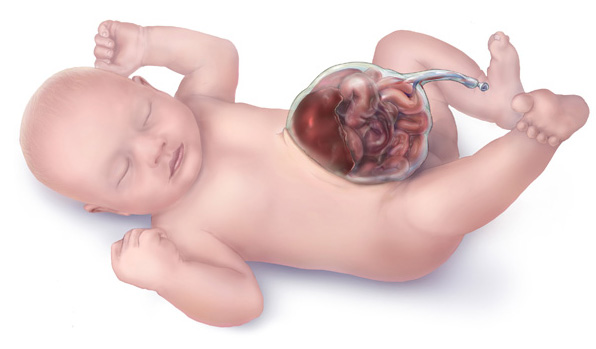 Omphalocele:
Omphalocele:
An abdominal defect in which the:
intestines, liver, and other organs remain outside the abdomen in a sac.
Omphaloceles are a defect in the development of the muscles of the abdominal wall.
Surgical Intervention is required to put the abdominal organs back into the abdominal cavity.
Differences of Gastroschisis and Omphalocele
Gastroschisis occurs when abdominal organs protrude freely through the abdominal wall during in-vitro development, without the presence of a protective sac.
In contrast, Omphalocele is observed in more developed fetuses. Despite the formation of a sac in the abdominal area that contains the organs, it does not develop completely, leading to the protrusion of the sac through the abdominal cavity.
How will I know if my Baby is at Risk?
Omphalocele is typically diagnosed through ultrasound, often following an elevated second-trimester maternal serum alpha-fetoprotein test. It occurs in around 1 in 10,000 births, characterized by the majority of the liver protruding into the umbilical cord. The herniation of the fetal liver is commonly linked to a smaller abdominal size, leading to the underdevelopment of the lungs. These factors may complicate the postnatal course after delivery.
Treatment Options
The size of the omphalocele herniation dictates the mode of delivery and postnatal care. If the omphalocele is small and doesn’t involve the liver, vaginal delivery might be an option.
After birth, surgery is performed to return the exposed organs to the abdominal cavity and close the herniation. The baby may need a ventilator for several days to assist with breathing. In cases of a larger omphalocele, a Cesarean delivery is typically chosen to prevent membrane rupture and liver trauma. Exposed organs are protected with a wrap, gradually returning to the abdominal cavity with gravity’s assistance. Sometimes, staged surgical repair is necessary before closing the omphalocele surgically.
During this period, the baby may be on a ventilator. Closing the abdominal wall defect through surgery may be delayed for six to 12 months, allowing the abdominal cavity to enlarge as the baby grows. Potential complications include respiratory issues, infections, and feeding difficulties.
Infants in omphalocele treatment initially receive intravenous feedings while their bowels recover. Once bowel function resumes, naso-gastric (NG) tube feedings are slowly introduced alongside continued IV feeds. Breast milk pumping and freezing are encouraged for NG feeds if tolerated, or a special formula can be given. NG feeds are gradually increased, and oral feedings are slowly introduced. This gradual process may lead to occasional setbacks, such as the need for bowel rest or additional surgery.
References
The Childrens Hospital of Philadelphia:
http://www.chop.edu/service/fetal-diagnosis-and-treatment/fetal-diagnoses/omphalocele.html
Short Bowel Syndrome Foundation, Inc.
Jon A Vanderhoof, MD, Rosemary J Young, NP-C-, MS, Andrew E Jablonski, A.A.S, B.A.
